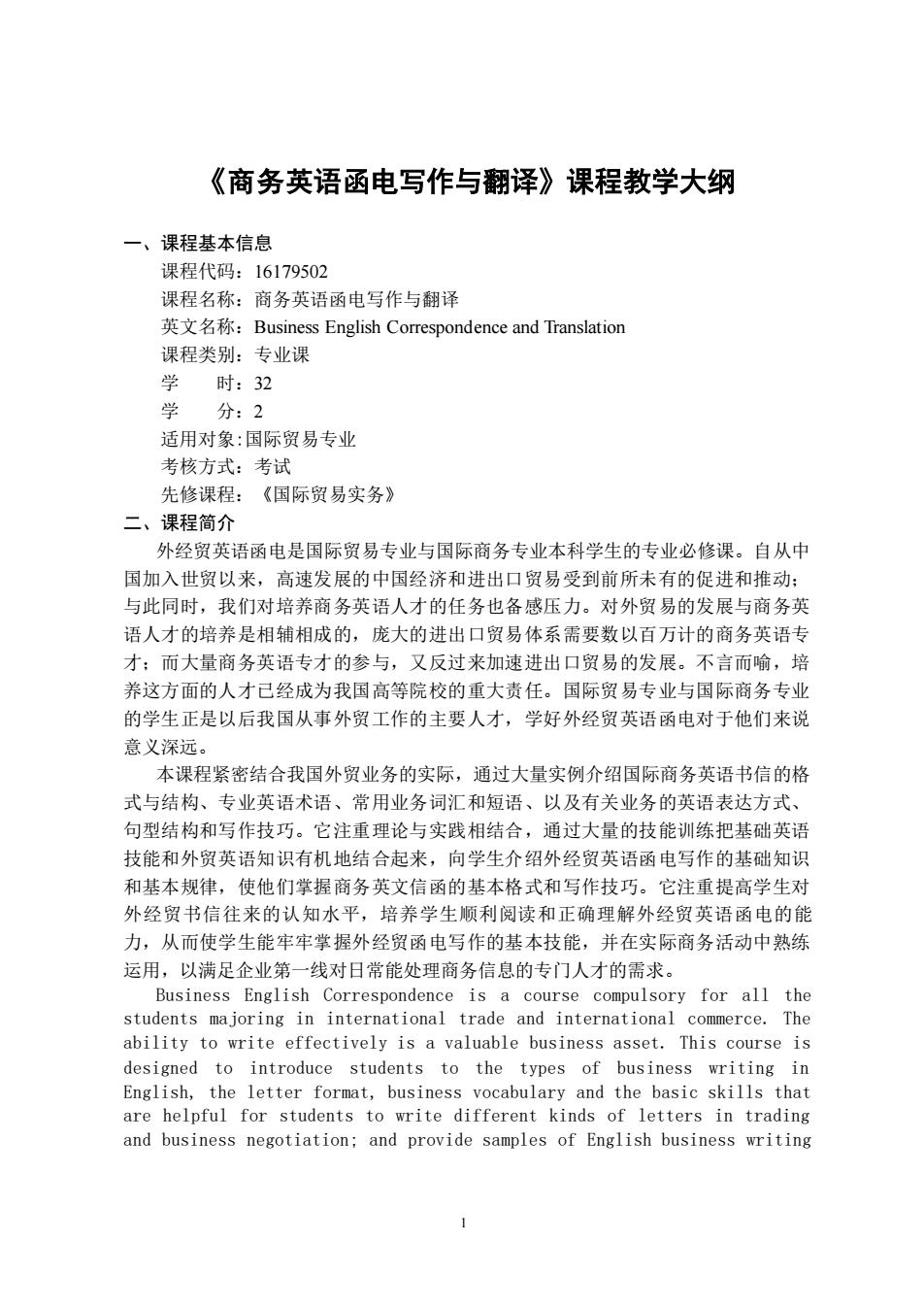
《商务英语函电写作与翻译》课程教学大纲 一、课程基本信息 课程代码:16179502 课程名称:商务英语函电写作与翻译 英文名称:Business English Correspondence and Translation 课程类别:专业课 学时:32 学分:2 适用对象:国际贸易专业 考核方式:考试 先修课程:《国际贸易实务》 二、课程简介 外经贸英语函电是国际贸易专业与国际商务专业本科学生的专业必修课。自从中 国加入世贸以来,高速发展的中国经济和进出口贸易受到前所未有的促进和推动: 与此同时,我们对培养商务英语人才的任务也备感压力。对外贸易的发展与商务英 语人才的培养是相辅相成的,庞大的进出口贸易体系需要数以百万计的商务英语专 才:而大量商务英语专才的参与,又反过来加速进出口贸易的发展。不言而喻,培 养这方面的人才己经成为我国高等院校的重大责任。国际贸易专业与国际商务专业 的学生正是以后我国从事外贸工作的主要人才,学好外经贸英语函电对于他们来说 意义深远。 本课程紧密结合我国外贸业务的实际,通过大量实例介绍国际商务英语书信的格 式与结构、专业英语术语、常用业务词汇和短语、以及有关业务的英语表达方式、 句型结构和写作技巧。它注重理论与实践相结合,通过大量的技能训练把基础英语 技能和外贸英语知识有机地结合起来,向学生介绍外经贸英语函电写作的基础知识 和基本规律,使他们掌握商务英文信函的基本格式和写作技巧。它注重提高学生对 外经贸书信往来的认知水平,培养学生顺利阅读和正确理解外经贸英语函电的能 力,从而使学生能牢牢掌握外经贸函电写作的基本技能,并在实际商务活动中熟练 运用,以满足企业第一线对日常能处理商务信息的专门人才的需求。 Business English Correspondence is a course compulsory for all the students majoring in international trade and international commerce.The ability to write effectively is a valuable business asset.This course is designed to introduce students to the types of business writing in English, the lette format,bu rocabulary and the basic skills tha are helpful for students to write different kinds of letters in trading and business negotiation;and provide samples of English business writing
1 《商务英语函电写作与翻译》课程教学大纲 一、课程基本信息 课程代码:16179502 课程名称:商务英语函电写作与翻译 英文名称:Business English Correspondence and Translation 课程类别:专业课 学 时:32 学 分:2 适用对象:国际贸易专业 考核方式:考试 先修课程:《国际贸易实务》 二、课程简介 外经贸英语函电是国际贸易专业与国际商务专业本科学生的专业必修课。自从中 国加入世贸以来,高速发展的中国经济和进出口贸易受到前所未有的促进和推动; 与此同时,我们对培养商务英语人才的任务也备感压力。对外贸易的发展与商务英 语人才的培养是相辅相成的,庞大的进出口贸易体系需要数以百万计的商务英语专 才;而大量商务英语专才的参与,又反过来加速进出口贸易的发展。不言而喻,培 养这方面的人才已经成为我国高等院校的重大责任。国际贸易专业与国际商务专业 的学生正是以后我国从事外贸工作的主要人才,学好外经贸英语函电对于他们来说 意义深远。 本课程紧密结合我国外贸业务的实际,通过大量实例介绍国际商务英语书信的格 式与结构、专业英语术语、常用业务词汇和短语、以及有关业务的英语表达方式、 句型结构和写作技巧。它注重理论与实践相结合,通过大量的技能训练把基础英语 技能和外贸英语知识有机地结合起来,向学生介绍外经贸英语函电写作的基础知识 和基本规律,使他们掌握商务英文信函的基本格式和写作技巧。它注重提高学生对 外经贸书信往来的认知水平,培养学生顺利阅读和正确理解外经贸英语函电的能 力,从而使学生能牢牢掌握外经贸函电写作的基本技能,并在实际商务活动中熟练 运用,以满足企业第一线对日常能处理商务信息的专门人才的需求。 Business English Correspondence is a course compulsory for all the students majoring in international trade and international commerce. The ability to write effectively is a valuable business asset. This course is designed to introduce students to the types of business writing in English, the letter format, business vocabulary and the basic skills that are helpful for students to write different kinds of letters in trading and business negotiation; and provide samples of English business writing
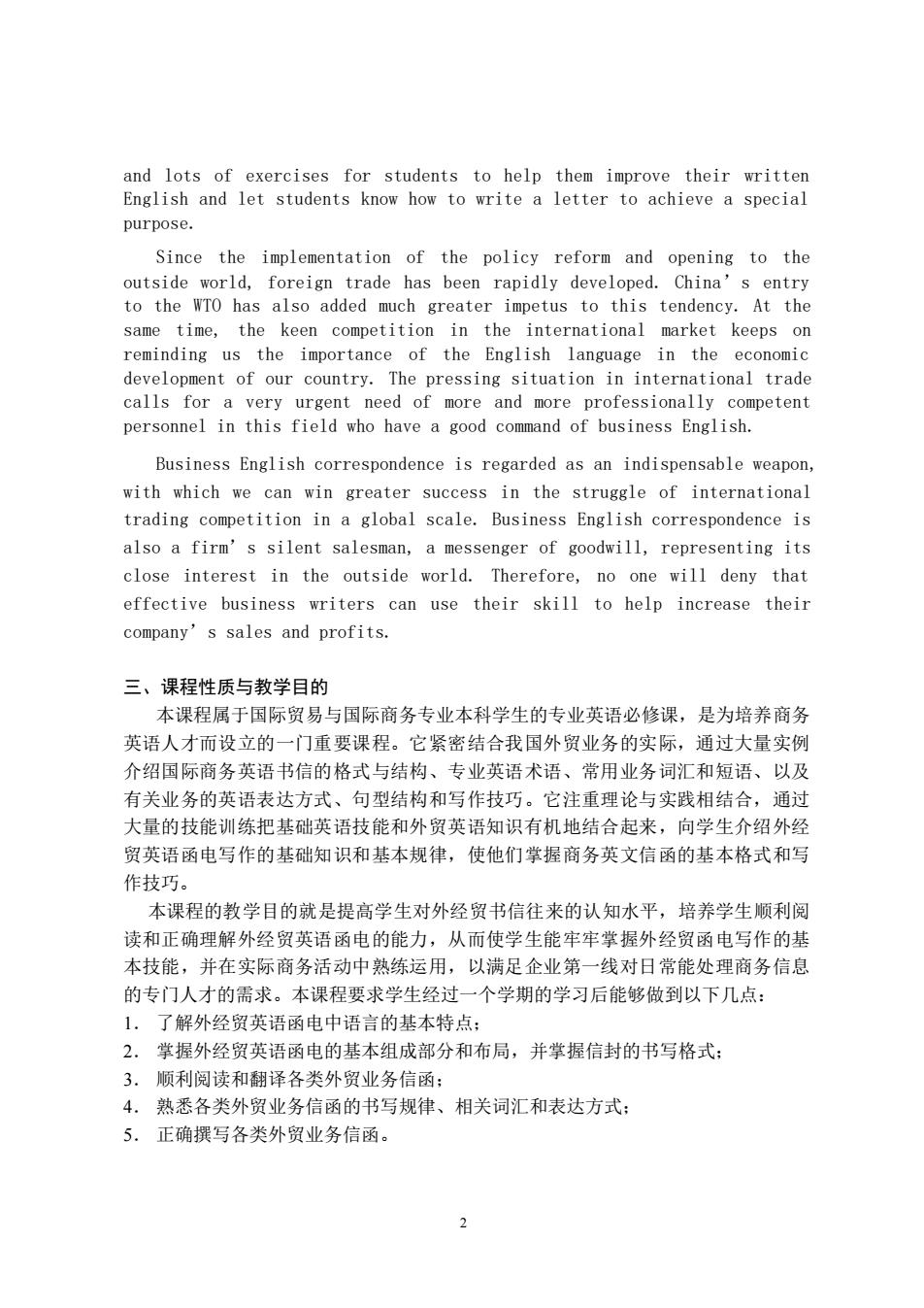
and lots of exercises for students to help them improve their written English and let students know how to write a letter to achieve a special purpose. Since the implementation of the policy reform and opening to the outside ord foreign trade has been ahinant to the wTo has also added much greater i same time, the keen competition in the international market keeps on reminding us the importance of the English language in the economic development of our country.The pressing situation in international trade calls for a very urgent need of more and more professionally competent personnel in this field who have a good command of business English. Business English correspondence is regarded as an indispensable weapon with which we can win greater success in the struggle of international trading competition in a global scale.Business English correspondence is also a firm's silent salesman,a messenger of goodwill,representing its close interest in the outside world.Therefore,no one will deny that effective business writers can use their skill to help increase their company's sales and profits. 三、课程性质与教学目的 本课程属于国际贸易与国际商务专业本科学生的专业英语必修课,是为培养商务 英语人才而设立的一门重要课程。它紧密结合我国外贸业务的实际,通过大量实例 介绍国际商务英语书信的格式与结构、专业英语术语、常用业务词汇和短语、以及 有关业务的英语表达方式、句型结构和写作技巧。它注重理论与实践相结合,通过 大量的技能训练把基础英语技能和外贸英语知识有机地结合起来,向学生介绍外经 贸英语函电写作的基础知识和基本规律,使他们掌握商务英文信函的基本格式和写 作技巧。 本课程的教学目的就是提高学生对外经贸书信往来的认知水平,培养学生顺利阅 读和正确理解外经贸英语函电的能力,从而使学生能牢牢掌握外经贸函电写作的基 本技能,并在实际商务活动中熟练运用,以满足企业第一线对日常能处理商务信息 的专门人才的需求。本课程要求学生经过一个学期的学习后能够做到以下几点: 1,了解外经贸英语函电中语言的基本特点: 2.掌握外经贸英语函电的基本组成部分和布局,并掌握信封的书写格式: 3.顺利阅读和翻译各类外贸业务信函: 4.熟悉各类外贸业务信函的书写规律、相关词汇和表达方式: 5.正确撰写各类外贸业务信函
2 and lots of exercises for students to help them improve their written English and let students know how to write a letter to achieve a special purpose. Since the implementation of the policy reform and opening to the outside world, foreign trade has been rapidly developed. China’s entry to the WTO has also added much greater impetus to this tendency. At the same time, the keen competition in the international market keeps on reminding us the importance of the English language in the economic development of our country. The pressing situation in international trade calls for a very urgent need of more and more professionally competent personnel in this field who have a good command of business English. Business English correspondence is regarded as an indispensable weapon, with which we can win greater success in the struggle of international trading competition in a global scale. Business English correspondence is also a firm’s silent salesman, a messenger of goodwill, representing its close interest in the outside world. Therefore, no one will deny that effective business writers can use their skill to help increase their company’s sales and profits. 三、课程性质与教学目的 本课程属于国际贸易与国际商务专业本科学生的专业英语必修课,是为培养商务 英语人才而设立的一门重要课程。它紧密结合我国外贸业务的实际,通过大量实例 介绍国际商务英语书信的格式与结构、专业英语术语、常用业务词汇和短语、以及 有关业务的英语表达方式、句型结构和写作技巧。它注重理论与实践相结合,通过 大量的技能训练把基础英语技能和外贸英语知识有机地结合起来,向学生介绍外经 贸英语函电写作的基础知识和基本规律,使他们掌握商务英文信函的基本格式和写 作技巧。 本课程的教学目的就是提高学生对外经贸书信往来的认知水平,培养学生顺利阅 读和正确理解外经贸英语函电的能力,从而使学生能牢牢掌握外经贸函电写作的基 本技能,并在实际商务活动中熟练运用,以满足企业第一线对日常能处理商务信息 的专门人才的需求。本课程要求学生经过一个学期的学习后能够做到以下几点: 1. 了解外经贸英语函电中语言的基本特点; 2. 掌握外经贸英语函电的基本组成部分和布局,并掌握信封的书写格式; 3. 顺利阅读和翻译各类外贸业务信函; 4. 熟悉各类外贸业务信函的书写规律、相关词汇和表达方式; 5. 正确撰写各类外贸业务信函

四、教学内容及要求 Unit One:Layout of Business Letters 1.Objectives:To let students 1)understand the functions and the essential qualities of business letters: 2)get familiar with the general layout of business letters and the tendency of business letter-writing. 3)Understand the differences of layout between Chinese letters and English letters,cultivating the value of Chinese traditional culture 2.Contents: Part One:Functions and Essentials of Business Letter-writing 1)The functions of a business letter are (a)to ask for or to convey information;(b)to make or accept an offer:(c)to deal with matters concerning negotiation of business. 2)There are certain essential qualities of business letters,which can be summed up in the Three C's,i.e.(a)Clearness;(b)Conciseness; (c)Courtesy.In some other books,more C's are added,such as Consideration,Concreteness,Correctness and Completeness. Part Two:Layout of Business Letters 1)Speaking of format,there are two main patterns in use at present.One is full block form:the other is modified block form with indented paragraphs. 2)The modern business letter is nearly always typed.It consists of seven principle parts:(a)the letter-head;(b)the date;(c)the inside name and address:(d)the salutation;(e)the message:(f)the complementary close and (g)the writer's signature and official position. 3.Questions and exercises: 1)What are the functions of a business letter? 2)What are the three C's? 3)What will be the result if a letter is ambiguous?How can this be avoided? 4)Do we use complicated words in our letters?
3 四、教学内容及要求 Unit One: Layout of Business Letters 1. Objectives: To let students 1) understand the functions and the essential qualities of business letters; 2) get familiar with the general layout of business letters and the tendency of business letter-writing. 3) Understand the differences of layout between Chinese letters and English letters, cultivating the value of Chinese traditional culture 2. Contents: Part One: Functions and Essentials of Business Letter-writing 1) The functions of a business letter are (a) to ask for or to convey information; (b) to make or accept an offer; (c) to deal with matters concerning negotiation of business. 2) There are certain essential qualities of business letters, which can be summed up in the Three C’s, i.e. (a) Clearness; (b) Conciseness; (c) Courtesy. In some other books, more C’s are added, such as Consideration, Concreteness, Correctness and Completeness. Part Two: Layout of Business Letters 1) Speaking of format, there are two main patterns in use at present. One is full block form; the other is modified block form with indented paragraphs. 2) The modern business letter is nearly always typed. It consists of seven principle parts: (a) the letter-head; (b) the date; (c) the inside name and address; (d) the salutation; (e) the message; (f) the complementary close and (g) the writer’s signature and official position. 3. Questions and exercises: 1) What are the functions of a business letter? 2) What are the three C’s? 3) What will be the result if a letter is ambiguous? How can this be avoided? 4) Do we use complicated words in our letters?
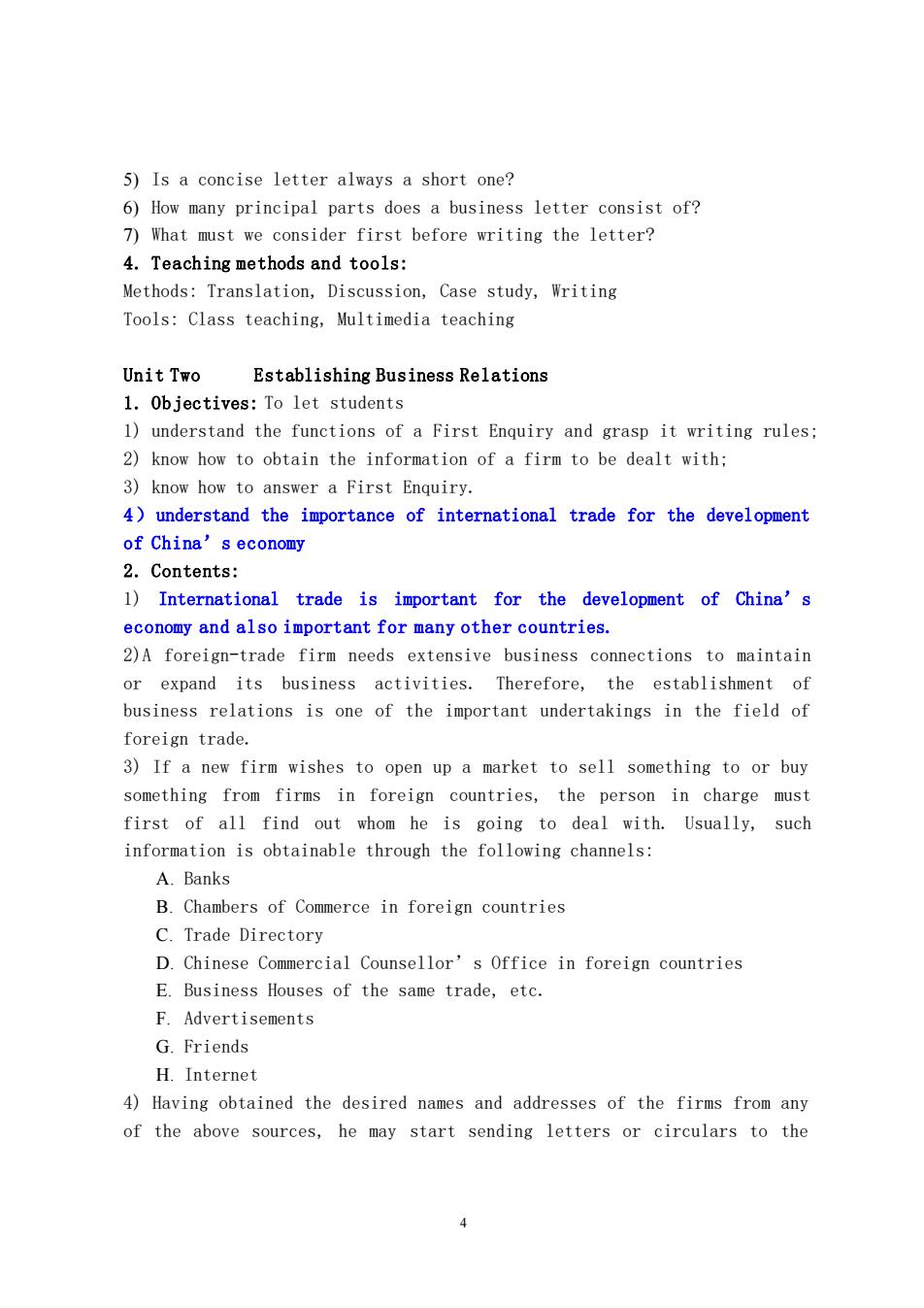
5)Is a concise letter always a short one? 6)How many principal parts does a business letter consist of? 7)What must we consider first before writing the letter? 4.Teaching methods and tools: Methods:Translation,Discussion,Case study,Writing Tools:Class teaching,Multimedia teaching Unit Two Establishing Business Relations 1.Objectives:To let students 1)understand the functions of a First Enquiry and grasp it writing rules; 2)know how to obtain the information of a firm to be dealt with: 3)know how to answer a First Enquiry. 4)understand the importance of international trade for the development of China's economy 2.Contents: 1)International trade is important for the development of China's economy and also important for many other countries. 2)A foreign-trade firm needs extensive business connections to maintain or expand its business activities.Therefore,the establishment of business relations is one of the important undertakings in the field of foreign trade. 3)If a new firm wishes to open up a market to sell something to or buy something from firms in foreign countries,the person in charge must first of all find out whom he is going to deal with.Usually,such information is obtainable through the following channels: A Banks B.Chambers of Commerce in foreign countries C.Trade Directory D.Chinese Commercial Counsellor's Office in foreign countries E.Business Houses of the same trade,etc. F.Advertisements G.Friends H.Internet 4)Having obtained the desired names and addresses of the firms from any of the above sources,he may start sending letters or circulars to the
4 5) Is a concise letter always a short one? 6) How many principal parts does a business letter consist of? 7) What must we consider first before writing the letter? 4. Teaching methods and tools: Methods: Translation, Discussion, Case study, Writing Tools: Class teaching, Multimedia teaching Unit Two Establishing Business Relations 1. Objectives: To let students 1) understand the functions of a First Enquiry and grasp it writing rules; 2) know how to obtain the information of a firm to be dealt with; 3) know how to answer a First Enquiry. 4)understand the importance of international trade for the development of China’s economy 2. Contents: 1) International trade is important for the development of China’s economy and also important for many other countries. 2)A foreign-trade firm needs extensive business connections to maintain or expand its business activities. Therefore, the establishment of business relations is one of the important undertakings in the field of foreign trade. 3) If a new firm wishes to open up a market to sell something to or buy something from firms in foreign countries, the person in charge must first of all find out whom he is going to deal with. Usually, such information is obtainable through the following channels: A. Banks B. Chambers of Commerce in foreign countries C. Trade Directory D. Chinese Commercial Counsellor’s Office in foreign countries E. Business Houses of the same trade, etc. F. Advertisements G. Friends H. Internet 4) Having obtained the desired names and addresses of the firms from any of the above sources, he may start sending letters or circulars to the
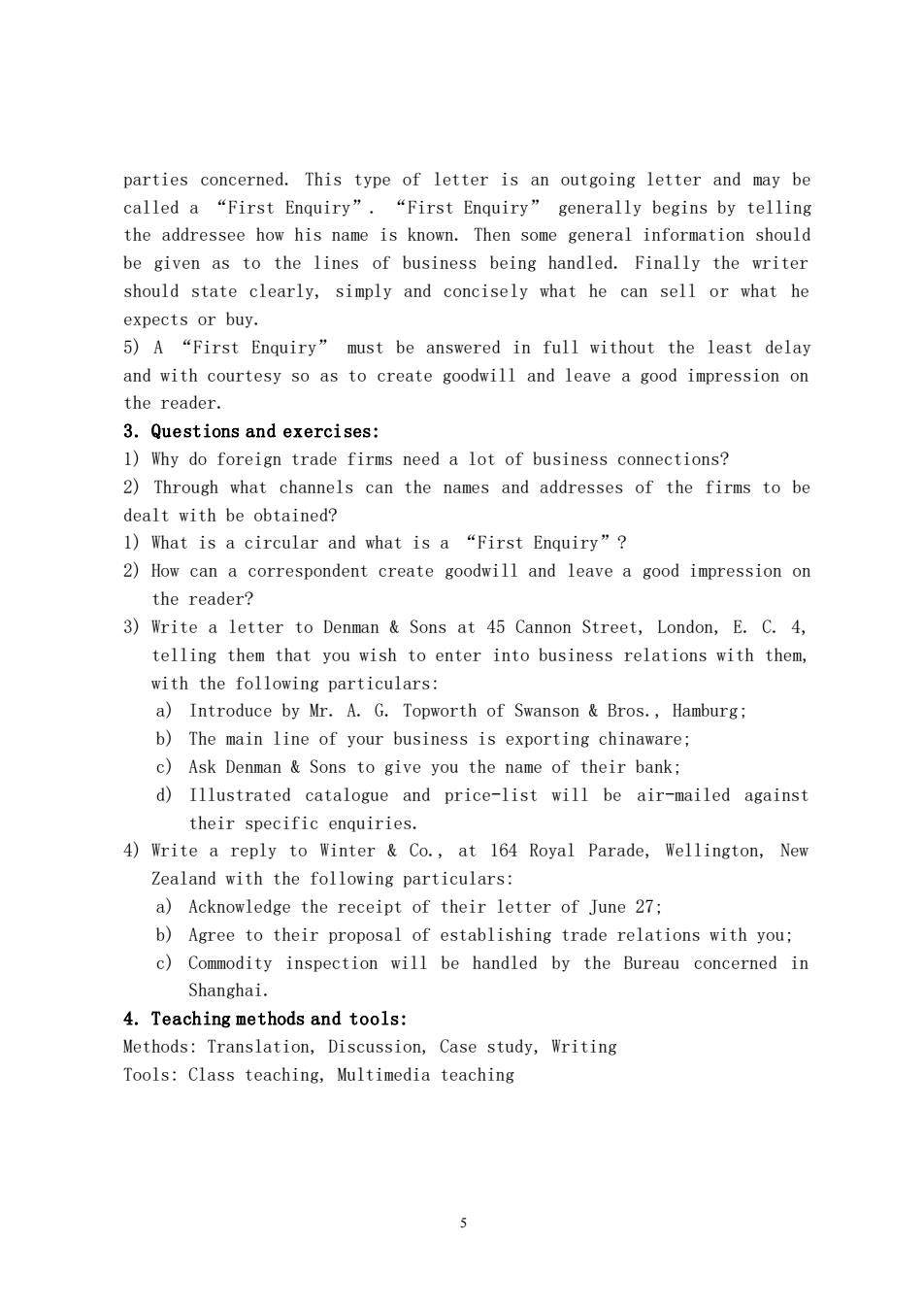
parties concerned.This type of letter is an outgoing letter and may be called a“First Enquiry”.“First Enquiry”generally begins by telling the addressee how his name is known.Then some general information should be given as to the lines of business being handled.Finally the writer should state clearly.simply and concisely what he can sell or what he expects or buy. 5)A "First Enquiry"must be answered in full without the least delay and with courtesy so as to create goodwill and leave a good impression on the reader. 3.Questions and exercises: 1)Why do foreign trade firms need a lot of business connections? 2)Through what channels can the names and addresses of the firms to be dealt with be obtained? 1)What is a circular and what is a "First Enquiry"? 2)How can a correspondent create goodwill and leave a good impression on the reader? 3)Write a letter to Denman Sons at 45 Cannon Street,London,E.C.4, telling them that you wish to enter into business relations with them, with the following particulars: a)Introduce by Mr.A.G.Topworth of Swanson Bros.,Hamburg: b)The main line of your business is exporting chinaware; c)Ask Denman Sons to give you the name of their bank: d)Illustrated catalogue and price-list will be air-mailed against their specific enquiries. 4)Write a reply to Winter Co.,at 164 Royal Parade,Wellington,New Zealand with the following particulars: a)Acknowledge the receipt of their letter of June 27; b)Agree to their proposal of establishing trade relations with you c)Commodity inspection will be handled by the Bureau concerned in Shanghai. 4.Teaching methods and tools: Methods:Translation,Discussion,Case study,Writing Tools:Class teaching,Multimedia teaching
5 parties concerned. This type of letter is an outgoing letter and may be called a “First Enquiry”. “First Enquiry” generally begins by telling the addressee how his name is known. Then some general information should be given as to the lines of business being handled. Finally the writer should state clearly, simply and concisely what he can sell or what he expects or buy. 5) A “First Enquiry” must be answered in full without the least delay and with courtesy so as to create goodwill and leave a good impression on the reader. 3. Questions and exercises: 1) Why do foreign trade firms need a lot of business connections? 2) Through what channels can the names and addresses of the firms to be dealt with be obtained? 1) What is a circular and what is a “First Enquiry”? 2) How can a correspondent create goodwill and leave a good impression on the reader? 3) Write a letter to Denman & Sons at 45 Cannon Street, London, E. C. 4, telling them that you wish to enter into business relations with them, with the following particulars: a) Introduce by Mr. A. G. Topworth of Swanson & Bros., Hamburg; b) The main line of your business is exporting chinaware; c) Ask Denman & Sons to give you the name of their bank; d) Illustrated catalogue and price-list will be air-mailed against their specific enquiries. 4) Write a reply to Winter & Co., at 164 Royal Parade, Wellington, New Zealand with the following particulars: a) Acknowledge the receipt of their letter of June 27; b) Agree to their proposal of establishing trade relations with you; c) Commodity inspection will be handled by the Bureau concerned in Shanghai. 4. Teaching methods and tools: Methods: Translation, Discussion, Case study, Writing Tools: Class teaching, Multimedia teaching

Unit Three Enquiries and Replies 1.Objectives:To let students 1)understand the aim of making enquiry and what a "first enquiry"is; 2)learn the general rules that should be observed when writing or answering an enquiry letter. 3)understand the differences of phrases used for polite inquiries between chinese and english 2.Contents: 1)In foreign trade,enquiries are usually made by the buyers without engagement to get information about the goods to be ordered,such as price,catalogue,delivery date and other terms.Enquiries may be either dispatched by mail,cable,telex,fax,email or handed to the suppliers through personal contact. 2)It is essential in making enquiries to consider carefully to which region or regions the enquiries are to be sent and how many suppliers are to be approached in one and the same region.Failure to take into consideration the relevant situation would lead to an adverse effect on future transactions. 3)If your are an enquirer,you should state clearly in your enquiries to foreign suppliers your exact requirements,inclusive of price,discounts, terms of payment,and the length of time required for delivery.There is no need for long,over-polite phrases and still less for humbleness. Nowadays,many firms even use a printed enquiry form instead of a letter. 4)A "first enquiry",that is an enquiry sent to a supplier whom you have not previously dealt with,should begin by telling him how you obtained his name.Some details of your own business,such the kind of goods handled,quantities needed,usual terms of trade and any information likely to enable the supplier to decide what he can do for you,will also help. 5)Enquiries should be addressed to the company because,in this way, your letter will receive quick attention.If you address the enquiries to an individual,your letter may have to wait while he is away.Or you may make a mistake and address it to the wrong individual,and this will also mean delay. 6)In conclusion,enquiries should be brief,specific,courteous and 6
6 Unit Three Enquiries and Replies 1. Objectives: To let students 1) understand the aim of making enquiry and what a “first enquiry” is; 2) learn the general rules that should be observed when writing or answering an enquiry letter. 3) understand the differences of phrases used for polite inquiries between Chinese and English 2. Contents: 1) In foreign trade, enquiries are usually made by the buyers without engagement to get information about the goods to be ordered, such as price, catalogue, delivery date and other terms. Enquiries may be either dispatched by mail, cable, telex, fax, email or handed to the suppliers through personal contact. 2) It is essential in making enquiries to consider carefully to which region or regions the enquiries are to be sent and how many suppliers are to be approached in one and the same region. Failure to take into consideration the relevant situation would lead to an adverse effect on future transactions. 3) If your are an enquirer, you should state clearly in your enquiries to foreign suppliers your exact requirements, inclusive of price, discounts, terms of payment, and the length of time required for delivery. There is no need for long, over-polite phrases and still less for humbleness. Nowadays, many firms even use a printed enquiry form instead of a letter. 4) A “first enquiry”, that is an enquiry sent to a supplier whom you have not previously dealt with, should begin by telling him how you obtained his name. Some details of your own business, such the kind of goods handled, quantities needed, usual terms of trade and any information likely to enable the supplier to decide what he can do for you, will also help. 5) Enquiries should be addressed to the company because, in this way, your letter will receive quick attention. If you address the enquiries to an individual, your letter may have to wait while he is away. Or you may make a mistake and address it to the wrong individual, and this will also mean delay. 6) In conclusion, enquiries should be brief, specific, courteous and
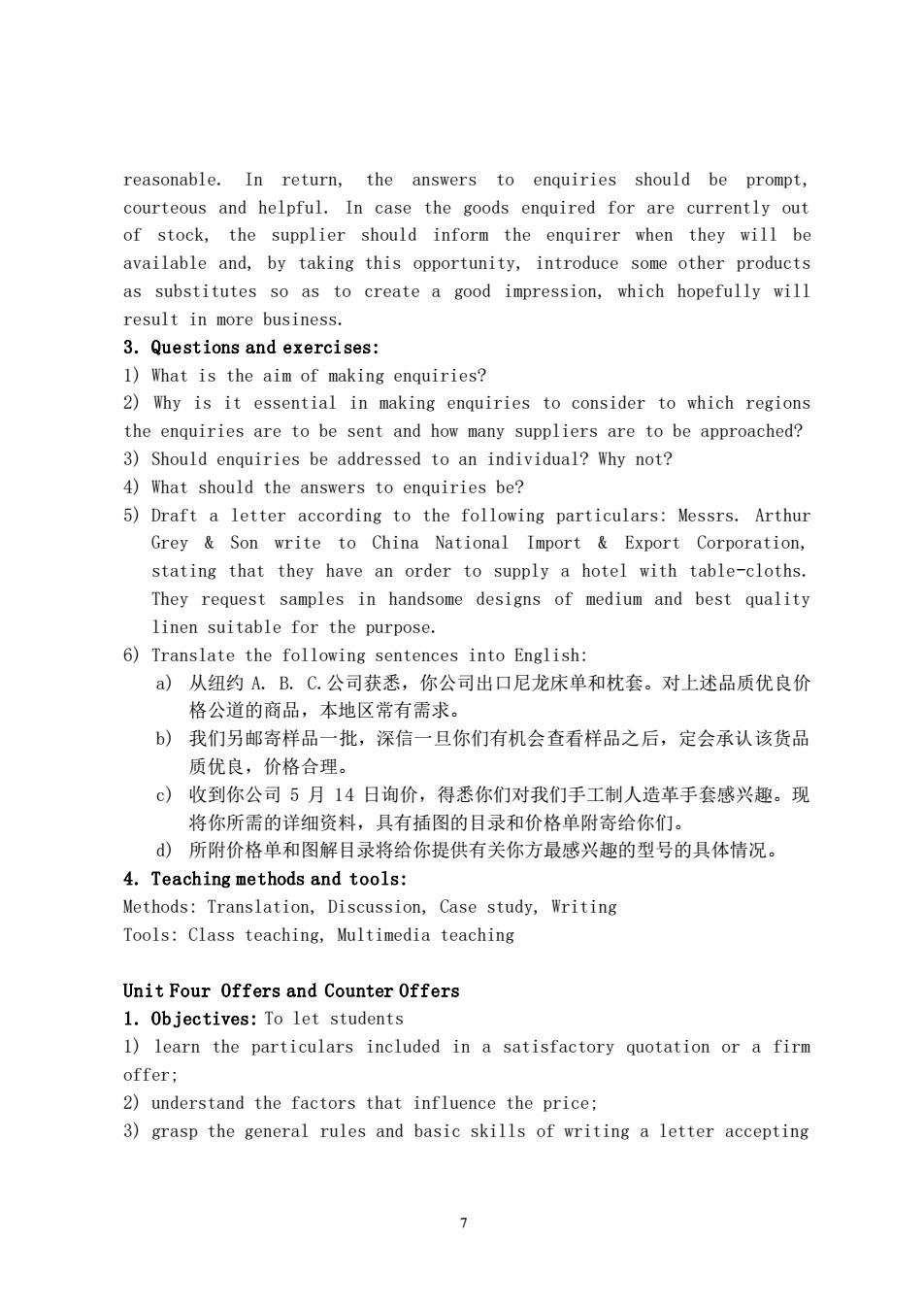
reasonable.In return,the answers to enquiries should be prompt, courteous and helpful.In case the goods enquired for are currently out of stock,the supplier should inform the enquirer when they will be available and,by taking this opportunity,introduce some other products as substitutes so as to create a good impression,which hopefully will result in more business. 3.Questions and exercises: 1)What is the aim of making enquiries? 2)Why is it essential in making enquiries to consider to which regions the enquiries are to be sent and how many suppliers are to be approached? 3)Should enquiries be addressed to an individual?Why not? 4)What should the answers to enquiries be? 5)Draft a letter according to the following particulars:Messrs.Arthur Grey Son write to China National Import Export Corporation, stating that they have an order to supply a hotel with table-cloths. They request samples in handsome designs of medium and best quality linen suitable for the purpose. 6)Translate the following sentences into English: )从纽约A.B.C.公司获悉,你公司出口尼龙床单和枕套。对上述品质优良价 格公道的商品,本地区常有需求。 b)我们另邮寄样品一批,深信一旦你们有机会查看样品之后,定会承认该货品 质优良,价格合理。 c)收到你公司5月14日询价,得悉你们对我们手工制人造革手套感兴趣。现 将你所需的详细资料,具有插图的目录和价格单附寄给你们。 )所附价格单和图解目录将给你提供有关你方最感兴趣的型号的具体情况。 4.Teaching methods and tools: Methods:Translation,Discussion,Case study,Writing Tools:Class teaching,Multimedia teaching Unit Four Offers and Counter Offers 1.Objectives:To let students 1)learn the particulars included in a satisfactory quotation or a firm offer: 2)understand the factors that influence the price; 3)grasp the general rules and basic skills of writing a letter accepting
7 reasonable. In return, the answers to enquiries should be prompt, courteous and helpful. In case the goods enquired for are currently out of stock, the supplier should inform the enquirer when they will be available and, by taking this opportunity, introduce some other products as substitutes so as to create a good impression, which hopefully will result in more business. 3. Questions and exercises: 1) What is the aim of making enquiries? 2) Why is it essential in making enquiries to consider to which regions the enquiries are to be sent and how many suppliers are to be approached? 3) Should enquiries be addressed to an individual? Why not? 4) What should the answers to enquiries be? 5) Draft a letter according to the following particulars: Messrs. Arthur Grey & Son write to China National Import & Export Corporation, stating that they have an order to supply a hotel with table-cloths. They request samples in handsome designs of medium and best quality linen suitable for the purpose. 6) Translate the following sentences into English: a) 从纽约 A. B. C.公司获悉,你公司出口尼龙床单和枕套。对上述品质优良价 格公道的商品,本地区常有需求。 b) 我们另邮寄样品一批,深信一旦你们有机会查看样品之后,定会承认该货品 质优良,价格合理。 c) 收到你公司 5 月 14 日询价,得悉你们对我们手工制人造革手套感兴趣。现 将你所需的详细资料,具有插图的目录和价格单附寄给你们。 d) 所附价格单和图解目录将给你提供有关你方最感兴趣的型号的具体情况。 4. Teaching methods and tools: Methods: Translation, Discussion, Case study, Writing Tools: Class teaching, Multimedia teaching Unit Four Offers and Counter Offers 1. Objectives: To let students 1) learn the particulars included in a satisfactory quotation or a firm offer; 2) understand the factors that influence the price; 3) grasp the general rules and basic skills of writing a letter accepting

or rejecting a quotation. 2.Contents: 1)An offer of goods is usually made either by way of advertisements, circulars and letters or in reply to enquiries.This is the first step in business negotiation. 2)In response to an enquiry,quotations may be sent.A satisfactory quotation will include the following: a.An expression of thanks for the enquiry; b.Details of prices,discounts and terms of payment; c.A statement or clear indication of what the prices cover (e.g. freight and insurance,etc): d.An undertaking as to date of delivery or time of shipment; e.The period for which the quotation is valid. 3)A firm offer is a promise to sell goods at a stated price,usually within a stated period of time.It must be clear,definite,complete and final.In making a firm offer,mention should be made of the time of shipment and the mode of payment desired:in addition,an exact description of the goods should be give and,if possible,pattern or sample sent 4)Complaints that prices are too high are usually met by references to the cost of raw materials,labor or transport,to the quality of the materials or the workmanship and sometimes to the rarity of the articles in question (antiques,etc.).A reference to your profit margin may also be sometimes required. 5)Prices may have to be raised because: A.the cost of raw materials has risen or B.the cost of moving the raw materials to the manufacturer has risen or C.the cost of production has risen (because of increase in rent, wages,energy charges,etc.)or D.the cost of moving the finished goods to the customer has risen (if the price quoted is not ex-works). 6)When a buyer rejects a quotation or other offer,he should write and thank the seller for his trouble and explain the reason for rejection. Not to do so would show a lack of courtesy.The letter of rejection 8
8 or rejecting a quotation. 2. Contents: 1) An offer of goods is usually made either by way of advertisements, circulars and letters or in reply to enquiries. This is the first step in business negotiation. 2) In response to an enquiry, quotations may be sent. A satisfactory quotation will include the following: a. An expression of thanks for the enquiry; b. Details of prices, discounts and terms of payment; c. A statement or clear indication of what the prices cover (e. g. freight and insurance, etc); d. An undertaking as to date of delivery or time of shipment; e. The period for which the quotation is valid. 3) A firm offer is a promise to sell goods at a stated price, usually within a stated period of time. It must be clear, definite, complete and final. In making a firm offer, mention should be made of the time of shipment and the mode of payment desired; in addition, an exact description of the goods should be give and, if possible, pattern or sample sent. 4) Complaints that prices are too high are usually met by references to the cost of raw materials, labor or transport, to the quality of the materials or the workmanship and sometimes to the rarity of the articles in question (antiques, etc.). A reference to your profit margin may also be sometimes required. 5) Prices may have to be raised because: A. the cost of raw materials has risen or B. the cost of moving the raw materials to the manufacturer has risen or C. the cost of production has risen (because of increase in rent, wages, energy charges, etc.) or D. the cost of moving the finished goods to the customer has risen (if the price quoted is not ex-works). 6) When a buyer rejects a quotation or other offer, he should write and thank the seller for his trouble and explain the reason for rejection. Not to do so would show a lack of courtesy. The letter of rejection
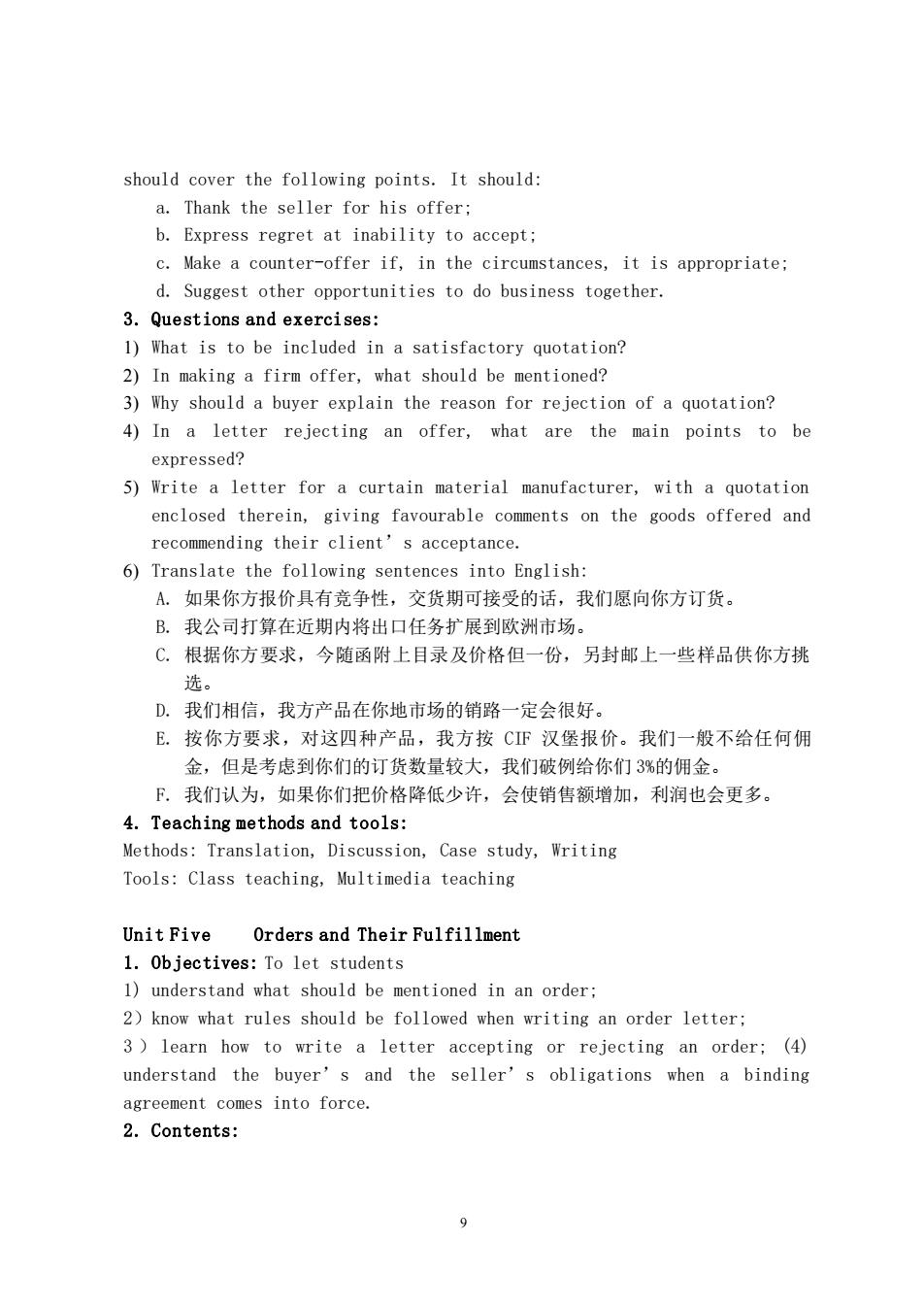
should cover the following points.It should: a.Thank the seller for his offer; b.Express regret at inability to accept: c.Make a counter-offer if,in the circumstances,it is appropriate; d.Suggest other opportunities to do business together. 3.Questions and exercises: 1)What is to be included in a satisfactory quotation? 2)In making a firm offer,what should be mentioned? 3)Why should a buyer explain the reason for rejection of a quotation? 4)In a letter rejecting an offer,what are the main points to be expressed? 5)Write a letter for a curtain material manufacturer,with a quotation enclosed therein,giving favourable comments on the goods offered and recommending their client's acceptance. 6)Translate the following sentences into English: A.如果你方报价具有竞争性,交货期可接受的话,我们愿向你方订货。 B.我公司打算在近期内将出口任务扩展到欧洲市场。 C.根据你方要求,今随函附上目录及价格但一份,另封邮上一些样品供你方挑 选。 D.我们相信,我方产品在你地市场的销路一定会很好。 E.按你方要求,对这四种产品,我方按C亚汉堡报价。我们一般不给任何佣 金,但是考虑到你们的订货数量较大,我们破例给你们3%的佣金。 R.我们认为,如果你们把价格降低少许,会使销售额增加,利润也会更多 4.Teaching methods and tools: Methods:Translation,Discussion,Case study,Writing Tools:Class teaching,Multimedia teaching Unit Five Orders and Their Fulfillment 1.Objectives:To let students 1)understand what should be mentioned in an order: 2)know what rules should be followed when writing an order letter; 3)learn how to write a letter accepting or rejecting an order:(4) understand the buyer's and the seller's obligations when a binding agreement comes into force. 2.Contents:
9 should cover the following points. It should: a. Thank the seller for his offer; b. Express regret at inability to accept; c. Make a counter-offer if, in the circumstances, it is appropriate; d. Suggest other opportunities to do business together. 3. Questions and exercises: 1) What is to be included in a satisfactory quotation? 2) In making a firm offer, what should be mentioned? 3) Why should a buyer explain the reason for rejection of a quotation? 4) In a letter rejecting an offer, what are the main points to be expressed? 5) Write a letter for a curtain material manufacturer, with a quotation enclosed therein, giving favourable comments on the goods offered and recommending their client’s acceptance. 6) Translate the following sentences into English: A. 如果你方报价具有竞争性,交货期可接受的话,我们愿向你方订货。 B. 我公司打算在近期内将出口任务扩展到欧洲市场。 C. 根据你方要求,今随函附上目录及价格但一份,另封邮上一些样品供你方挑 选。 D. 我们相信,我方产品在你地市场的销路一定会很好。 E. 按你方要求,对这四种产品,我方按 CIF 汉堡报价。我们一般不给任何佣 金,但是考虑到你们的订货数量较大,我们破例给你们 3%的佣金。 F. 我们认为,如果你们把价格降低少许,会使销售额增加,利润也会更多。 4. Teaching methods and tools: Methods: Translation, Discussion, Case study, Writing Tools: Class teaching, Multimedia teaching Unit Five Orders and Their Fulfillment 1. Objectives: To let students 1) understand what should be mentioned in an order; 2)know what rules should be followed when writing an order letter; 3 ) learn how to write a letter accepting or rejecting an order; (4) understand the buyer’s and the seller’s obligations when a binding agreement comes into force. 2. Contents:
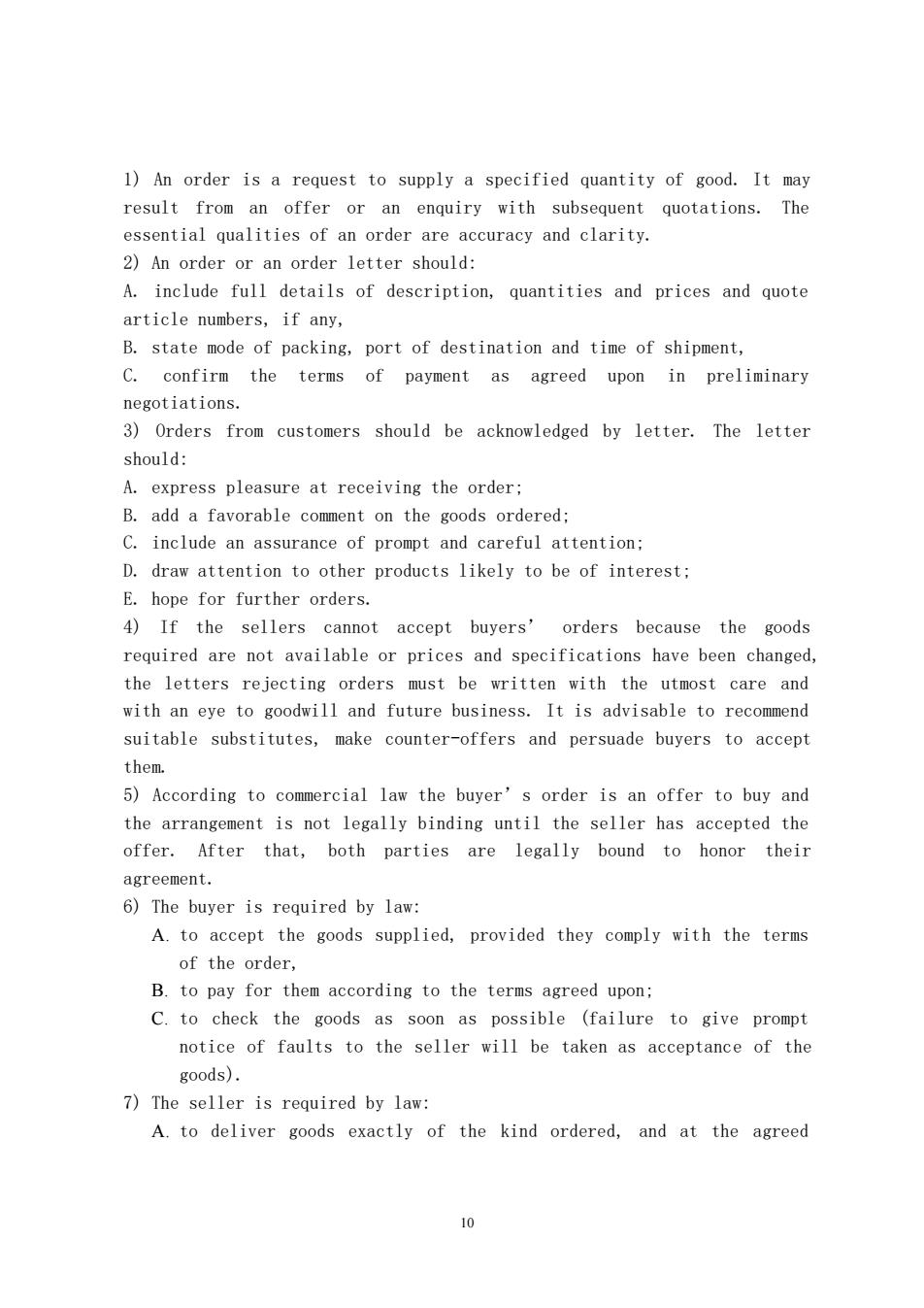
1)An order is a request to supply a specified quantity of good.It may result from an offer or an enquiry with subsequent quotations.The essential qualities of an order are accuracy and clarity. 2)An order or an order letter should: A.include full details of description.quantities and prices and quote article numbers,if any, B.state mode of packing,port of destination and time of shipment, C.confirm the terms of payment as agreed upon in preliminary negotiations. 3)Orders from customers should be acknowledged by letter.The letter should: A.express pleasure at receiving the order; B.add a favorable comment on the goods ordered; C.include an assurance of prompt and careful attention; D.draw attention to other products likely to be of interest: E.hope for further orders. 4)If the sellers cannot accept buyers'orders because the goods required are not available or prices and specifications have been changed, the letters rejecting orders must be written with the utmost care and with an eye to goodwill and future business.It is advisable to recommend suitable substitutes,make counter-offers and persuade buyers to accept them 5)According to commercial law the buyer's order is an offer to buy and the arrangement is not legally binding until the seller has accepted the offer.After that,both parties are legally bound to honor their agreement. 6)The buyer is required by law: A.to accept the goods supplied,provided they comply with the terms of the order, B.to pay for them according to the terms agreed upon C.to check the goods as soon as possible (failure to give prompt notice of faults to the seller will be taken as acceptance of the goods). 7)The seller is required by law: A.to deliver goods exactly of the kind ordered,and at the agreed 10
10 1) An order is a request to supply a specified quantity of good. It may result from an offer or an enquiry with subsequent quotations. The essential qualities of an order are accuracy and clarity. 2) An order or an order letter should: A. include full details of description, quantities and prices and quote article numbers, if any, B. state mode of packing, port of destination and time of shipment, C. confirm the terms of payment as agreed upon in preliminary negotiations. 3) Orders from customers should be acknowledged by letter. The letter should: A. express pleasure at receiving the order; B. add a favorable comment on the goods ordered; C. include an assurance of prompt and careful attention; D. draw attention to other products likely to be of interest; E. hope for further orders. 4) If the sellers cannot accept buyers’ orders because the goods required are not available or prices and specifications have been changed, the letters rejecting orders must be written with the utmost care and with an eye to goodwill and future business. It is advisable to recommend suitable substitutes, make counter-offers and persuade buyers to accept them. 5) According to commercial law the buyer’s order is an offer to buy and the arrangement is not legally binding until the seller has accepted the offer. After that, both parties are legally bound to honor their agreement. 6) The buyer is required by law: A. to accept the goods supplied, provided they comply with the terms of the order, B. to pay for them according to the terms agreed upon; C. to check the goods as soon as possible (failure to give prompt notice of faults to the seller will be taken as acceptance of the goods). 7) The seller is required by law: A. to deliver goods exactly of the kind ordered, and at the agreed